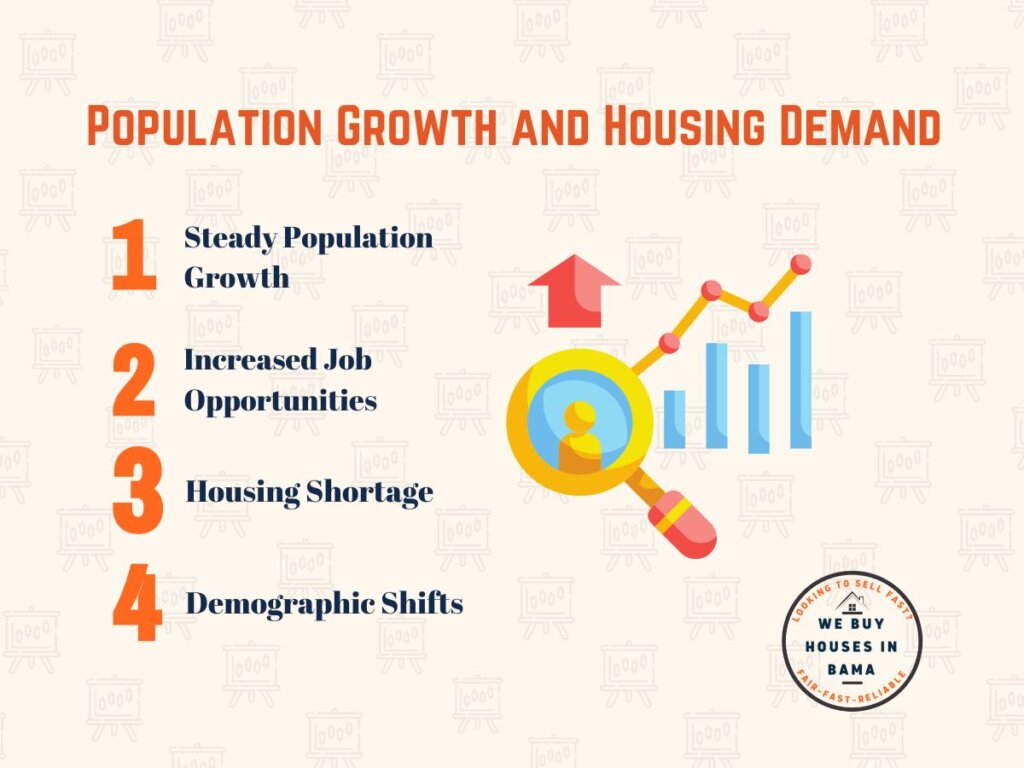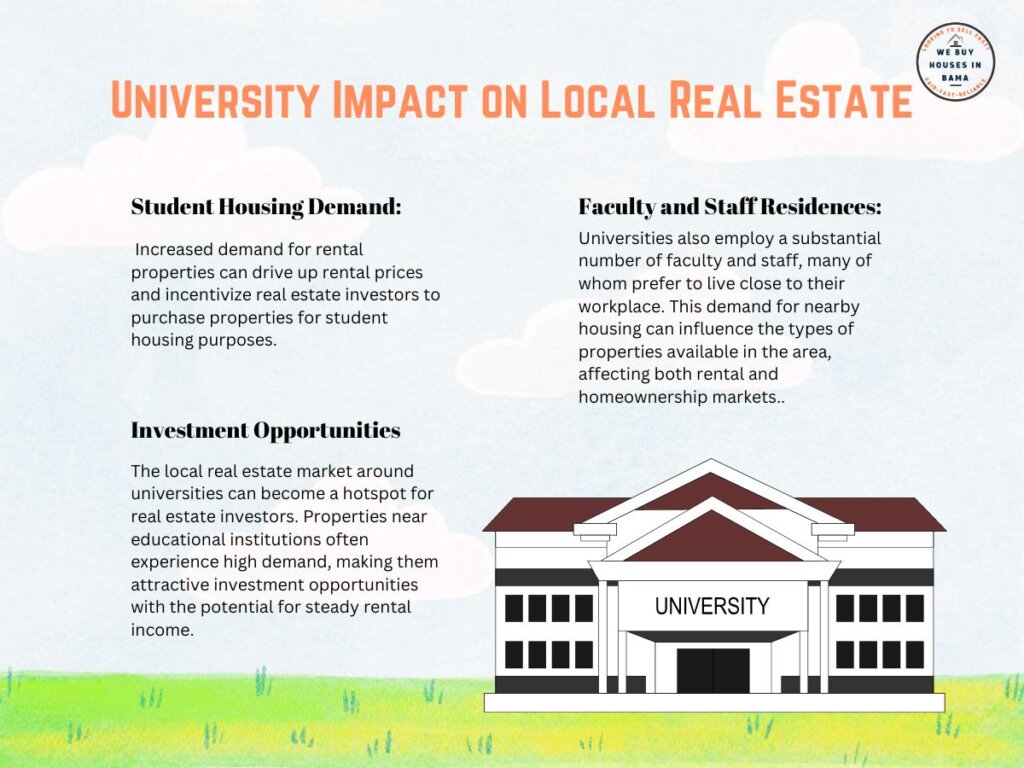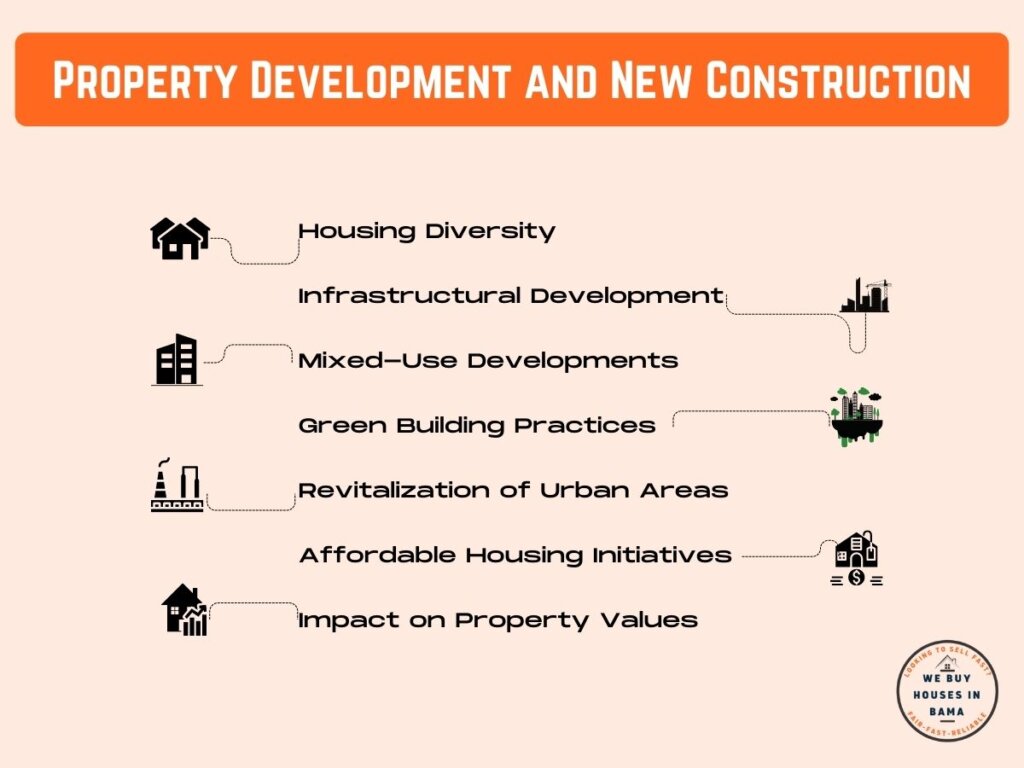You may be wondering , what is the impact of real estate market trends in Alabama ?Alabama’s real estate market has seen notable impacts due to shifting trends. The state’s housing landscape is evolving with steady population growth, rising demand for affordable housing, and a shift towards suburban areas.
Alabama’s real estate market has seen notable changes recently, with various housing options available, from vibrant urban centers to tranquil rural communities, reflecting the state’s rich history and charm.
As the Heart of Dixie, Alabama’s real estate market has been influenced by various economic, social, and demographic factors, shaping its current landscape. Let’s explore the key factors shaping the Alabama real estate market.
Population Growth and Housing Demand
The real estate market in Alabama has witnessed significant impacts due to population growth and the resulting increase in housing demand. This surge in population has led to a multitude of changes in the housing sector, affecting both buyers and sellers.

Here, we’ll explore the important interplay.
- Steady Population Growth: Alabama has experienced steady population growth in recent years, with an influx of people from other states and a rising number of young professionals seeking opportunities in the region. This influx has spurred a surge in housing demand.
- Increased Job Opportunities: The state’s growing economy has created more job opportunities, attracting individuals and families to move to Alabama. As job prospects expand, the demand for housing options intensifies.
- Housing Shortage: The influx of new residents, coupled with the lack of sufficient housing inventory, has caused a shortage in available properties. This shortage has contributed to rising property prices and intensified competition among buyers.
- Demographic Shifts: The changing population dynamics, with a higher proportion of young professionals and retirees, influence the types of properties in demand. Preferences shift towards smaller homes, condos, and properties with low maintenance requirements.
Shift to Suburban Living
In recent years, Alabama has witnessed a notable shift in lifestyle preferences, with an increasing number of people opting for suburban living over urban environments. This trend has significant implications for the real estate market and the overall development of the state.
Let’s explore the key factors contributing to this shift and its impact:
- Desire for Space and Privacy: Suburban living offers more space, larger properties, and a sense of privacy that is often lacking in urban areas. Families and individuals seeking a quieter and more relaxed lifestyle are drawn to the suburban neighborhoods of Alabama.
- Affordability: Compared to urban centers, suburban areas in Alabama typically offer more affordable housing options. Lower property prices and the possibility of obtaining larger homes attract homebuyers looking to make the most of their budgets.
- Family-Friendly Amenities: Suburban communities often boast family-friendly amenities such as parks, schools, and recreational facilities. This makes them an attractive choice for families with children who prioritize access to good schools and safe play areas.
- Commute and Traffic Considerations: Urban centers tend to face heavier traffic congestion and longer commutes. Suburban living allows residents to avoid the daily hustle of urban traffic and enjoy a more relaxed journey to work or other destinations.
- Improved Quality of Life: Suburban living is often associated with a better quality of life due to less noise pollution, reduced crime rates, and a stronger sense of community. These factors contribute to higher overall satisfaction with the living environment.
- Telecommuting and Remote Work: The rise of remote work and telecommuting opportunities has enabled people to choose where they live based on their preferences rather than proximity to their workplace. Suburban areas have become more appealing to those who no longer need to commute daily.
- Availability of Land for Development: Alabama’s suburban areas generally have more available land for new developments. This has led to a surge in the construction of new suburban communities, meeting the demand of those seeking to relocate.
- Diverse Housing Options: The shift to suburban living has prompted the development of diverse housing options, including single-family homes, townhouses, and condominiums, to accommodate the varying preferences of potential buyers.
University Impact on Local Real Estate
The presence of universities and colleges can have a significant influence on the real estate market in their respective areas. In Alabama, several cities host prominent educational institutions that contribute to the dynamics of the local housing sector.

Let’s delve into the ways in which universities impact the real estate landscape:
- Student Housing Demand: Universities attract a large number of students, many of whom seek off-campus housing options. This increased demand for rental properties can drive up rental prices and incentivize real estate investors to purchase properties for student housing purposes.
- Faculty and Staff Residences: Universities also employ a substantial number of faculty and staff, many of whom prefer to live close to their workplace. This demand for nearby housing can influence the types of properties available in the area, affecting both rental and homeownership markets.
- Investment Opportunities: The local real estate market around universities can become a hotspot for real estate investors. Properties near educational institutions often experience high demand, making them attractive investment opportunities with the potential for steady rental income.
Tourist Destinations and Vacation Rentals
Alabama is home to several attractive tourist destinations, ranging from pristine beaches along the Gulf of Mexico to historical sites and vibrant cities. The influx of tourists has led to a thriving vacation rental market, impacting both the local economy and the real estate sector.
Let’s explore the relationship between tourist destinations and vacation rentals in Alabama:
- Coastal Beach Towns: Alabama’s Gulf Coast is a popular destination for tourists seeking sun, sand, and sea. Beach towns like Gulf Shores and Orange Beach experience a surge in visitors during peak vacation seasons, creating a high demand for vacation rental properties.
- Historical and Cultural Sites: Cities like Mobile and Montgomery boast historical and cultural attractions, drawing in history enthusiasts and travelers. The demand for short-term vacation rentals in these areas increases as visitors seek authentic experiences and proximity to tourist sites.
- Seasonal Fluctuations: The vacation rental market in Alabama often experiences seasonal fluctuations. During warmer months and holiday periods, the demand for rentals is at its peak, while the off-season might see a decrease in bookings.
- Airbnb and Short-Term Rentals: Online platforms like Airbnb have revolutionized the vacation rental industry, making it easier for property owners to list and rent out their spaces to tourists. This has contributed to the rapid growth of the short-term rental market in Alabama.
- Sustainable Tourism Practices: As the vacation rental market expands, there is an increasing focus on sustainable tourism practices. Property owners and managers are encouraged to adopt eco-friendly measures to reduce the environmental impact of tourism.
Coastal Concerns and Property Values
Alabama’s beautiful coastline along the Gulf of Mexico attracts many residents and tourists seeking to enjoy the beaches and ocean views. However, coastal areas are also vulnerable to various environmental concerns that can impact property values.
- Hurricane and Storm Risks: Coastal regions are susceptible to hurricanes and severe storms, which can cause extensive damage to properties. The risk of such natural disasters can affect property values, with potential buyers and insurers considering the level of risk associated with coastal living.
- Flood Zones and Insurance Costs: Some coastal areas are designated as flood zones, and properties located in these zones may require costly flood insurance. The increased insurance costs can impact affordability and influence property buyers’ decisions.
- Insurance Availability: Insurance companies might become more cautious about insuring properties in high-risk coastal areas. Reduced availability of insurance coverage or higher premiums can affect property affordability and market appeal.
- Erosion and Sea Level Rise: Coastal erosion and sea level rise are ongoing environmental challenges. As beaches erode and sea levels gradually rise, properties close to the shore may face a higher risk of damage and decreased desirability, leading to potential devaluation.
- Property Resilience and Mitigation: Homebuyers may look for properties that have undergone resilience and mitigation measures to protect against environmental risks. Features like hurricane-resistant windows and elevated foundations can increase property values.
- Public Access and Views: Properties with direct beach access or unobstructed ocean views often command higher prices due to their premium locations. Restrictions on public beach access or potential obstructions can impact property values in coastal areas.
Property Development and New Construction
Property development and new construction are vital components of Alabama’s real estate landscape. As the state continues to grow and evolve, new construction projects play a significant role in meeting the demands of a changing population and economy.

- Housing Diversity: New construction offers the opportunity to diversify housing options in the state. Developers can introduce a range of housing types, including single-family homes, townhouses, condominiums, and apartments, catering to the preferences of various buyers.
- Infrastructural Development: Property development often involves infrastructural improvements and expansions, such as roads, utilities, and public services, to accommodate the needs of growing communities.
- Mixed-Use Developments: There is a rising trend towards mixed-use developments, combining residential, commercial, and recreational spaces within the same project. These developments create vibrant communities with easy access to amenities and services.
- Green Building Practices: Many developers are adopting green building practices, incorporating sustainable features in their projects to promote energy efficiency and reduce environmental impact.
- Revitalization of Urban Areas: Property development can revitalize urban areas by transforming underutilized or abandoned properties into vibrant new spaces, attracting residents, businesses, and investment.
- Affordable Housing Initiatives: New construction projects may include initiatives to address the need for affordable housing in the state. Developers, in collaboration with local authorities, may build affordable housing units to increase housing accessibility.
- Impact on Property Values: New construction can have a ripple effect on surrounding property values. The introduction of high-quality developments in an area can increase its overall desirability and contribute to the appreciation of nearby properties.
Key Takeaway
As the real estate market evolves, staying informed about the latest trends is crucial for making informed decisions. Buyers, sellers, and investors should keep track of market dynamics, housing demand, and development trends to seize opportunities and navigate potential challenges.
In a dynamic real estate market, being proactive and working with knowledgeable professionals can lead to successful transactions. Whether buying a new home, investing in a property, or exploring commercial opportunities, staying informed and taking timely action is vital for success in the evolving Alabama real estate landscape.
